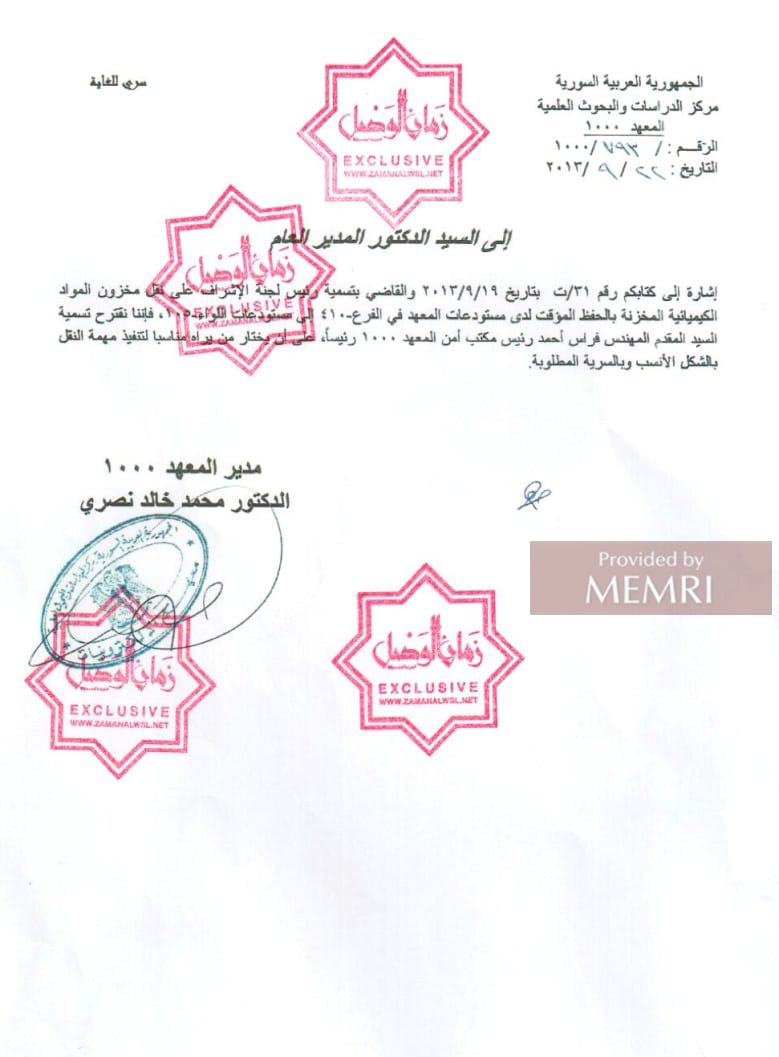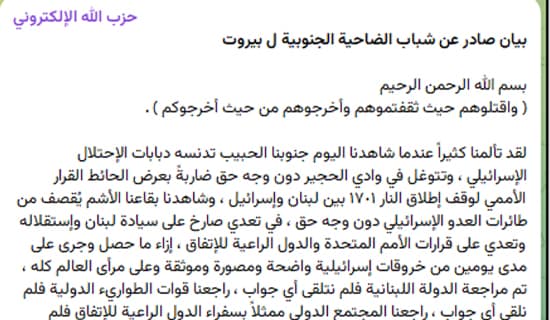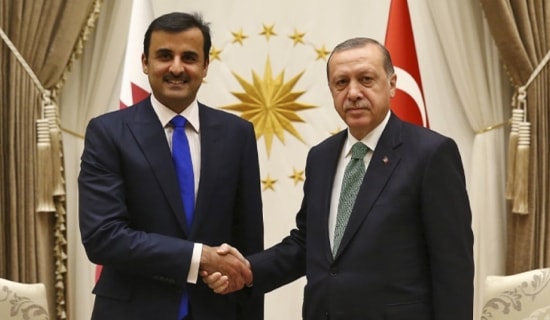Throughout the Syria war, the Syrian regime has been accused of employing chemical weapons against combatants and the civilian population; the incident that drew the world's attention to this issue was the August 2013 chemical attack on Damascus's Eastern Ghouta suburb, in which hundreds of civilians were killed. This attack prompted then-U.S. President Barack Obama to threaten a military strike against the regime, which Russia, the regime's ally, prevented by promoting an agreement under which the regime was to surrender all its chemical weapons for dismantling and destruction.
Despite the June 23, 2014 announcement by Ahmet Üzümcü, director-general of the Organization for the Prohibition of Chemical Weapons (OPCW), that the removal of the chemical weapons from Syria had been completed,[1] Syrian opposition elements continued to report almost daily chemical attacks by the Syrian regime. The worst of these was in April 2017 in the town of Khan Shaykhun, south of Idlib, which reportedly killed about 100 people. In response to this attack, U.S. President Donald Trump ordered a strike on the Shyrat airbase, from which the Khan Shaykhun attack had been launched.
The Syrian regime, for its part, repeatedly denied the allegations against it, claiming that the opposition and ISIS were responsible for the chemical attacks.
To confirm the claims of the opposition elements, last month the Syrian opposition website Zamanalwsl.net published two reports, of uncertain credibility, about secret stores of chemical weapons belonging to the Syrian regime. On November 2, 2017, the website published what it claimed was an official Syrian regime document proving that, prior to the September 2013 arrival in Damascus of OPCW inspectors to begin dismantling chemical weapons, the regime had transferred some of the chemicals to a secret location. The article included testimony by a source who claimed to have participated in the transfer of the chemicals. On November 14, the website published statements by a man formerly employed at a secret site near Damascus where, he said, chemicals were produced.
The following are extensive translated excerpts from the reports published by Zamanalwsl.net:
Zamanalwsl.net Publishes Official Regime Document Ordering Concealment Of Chemical Agents
As noted, on November 2, 2017, Zamanalwsl.net published what it alleged was an official Syrian regime document dated September 2013 that ordered the transfer of chemicals from a site known to be a chemical weapons manufacturing facility to another site. The following is the translation of the document:
"TOP SECRET
"The Arab Republic of Syria
"The Scientific Studies and Research Center
"Institute 1000
"Re: 1000/793
"Date: September 22, 2013
"To: Dr. Director-General
"With regard to the letters in reference to 31/T of September 19, 2013 ordering the appointment of a chairman of the committee for overseeing the transfer of the inventory of chemicals temporarily warehoused at the institute [i.e. Institute 1000] at Branch 410 to the warehouses at the 105th Brigade, we propose the appointment of an officer of high rank, Engineer Fares Ahmad, head of the security office at Institute 1000, as head [of the committee overseeing the transfer]. He will choose people he finds suitable to carry out the mission of the transfer in the best possible way and with the necessary secrecy.
"Director, Institute 1000
"Dr. Muhammad Khaled Nasri

The document published by Zamanalwsl.net, November 2, 2017.
According to Zamanalwsl, this document "incriminates the regime of Bashar Al-Assad and exposes his manipulation in the matter of handing over his entire inventory of chemicals, days before the UN experts arrived [in Syria] in order to begin taking steps to dismantle the regime's chemical weapons in accordance with the U.S.-Russia deal set out in the binding UN Resolution 2118."
The website stressed that the order to appoint a head of the committee overseeing the transfer of the chemicals was issued on September 19, 2013 – the date the regime officially handed over to the OPCW the list of sites where chemicals were manufactured and stored. It added: "The date of the document itself – September 22, 2013 – reveals that the regime was racing against time to transfer its inventory of chemicals from one place to another, in an attempt to deceive everyone, because the experts [who were to] dismantle the chemical [weapons] arrived in Damascus eight days after the date of the document, in order to begin their work.
"Likewise, the document was written days before the OPCW issued, on September 27, a resolution concerning the Syrian regime's chemical [weapons], that warned that [the regime might] attempt to hide or transfer them. The same day, UN Security Council Resolution 2118 was passed; it concerns the destruction of the Syrian regime's chemical [weapons], and stated explicitly in one of its paragraphs that 'no party in Syria should use, develop, produce, acquire, stockpile, retain, or transfer chemical weapons.' The resolution also warned that any violation of one or all of its sections, 'including unauthorized transfer of chemical weapons' will require 'to impose measures under Chapter VII of the United Nations Charter' that allows the use of military force."[2]
Report: Statements By Employee Who Helped Transfer Chemicals From Institute 1000 To 105th Brigade
In support of the credibility of the document it published, Zamanalwsl also published statements of "one of the people who participated in the transfer of the inventory of chemicals from Institute 1000 to the 105th Brigade." It wrote: "The source [making the statements] stressed that the actual preparations for transferring the inventory of chemicals began on September 24, and the operation took a week. In order to carry out the mission, 50 men were selected from the regime forces, in accordance with their ethnic loyalty [i.e. Alawites] and under the oversight of Brig.-Gen. Yusuf 'Ajib, security officer of the [Syrian] Scientific Studies and Research Center and with the participation of Lt.-Gen. Fares Ahmad, security officer of Institute 1000, who is mentioned in the document."
The source stated that the men selected to carry out the transfer were divided into five equal groups before being transferred from the Barzeh area in northern Damascus to the Jamraya area, where they began their work, on September 25, 2013, in the middle of the night. They loaded tanks full of chemicals onto five closed refrigerated trucks, and each truck left as soon as it was fully loaded for the 105th Brigade, where it was unloaded.
The source noted that "the new storage place was in an underground tunnel at the 105th Brigade," and that to the best of his knowledge "a parallel operation was also carried out to transfer a different inventory [of chemicals] from Institute 2000 to the 105th Brigade."
The report also gave information about Institute 1000 and the 105th Brigade: "Institute 1000 is situated in the Jamraya region, behind Mount Qasioun, northwest of Damascus. [It] belongs to Branch 410, and was established in coordination with the Soviets in the 1980s. The institute is known for its research activity for producing chemical weapons."

Photo of facilities at Institute 1000, Jamraya, Syria (image: Zamanalwsl, November 2, 2017)
The report continued: "The 105th Brigade is an element that has the greatest military control and influence in Syria, and to prove this we only need to look at the names of some of those who have commanded it: Basel Al-Assad [Assad's brother, who had been groomed to be the heir to their father, President Hafez Al-Assad, but was killed in 1994]; Bashar Al-Assad [himself], Manef Tlass [son of former defense minister Mustafa Tlass who defected in July 2012] and Talal Makhlouf, the current national commander of the Republican Guard. The 105th Brigade and Institute 1000 are situated in approximately the same region, a few kilometers apart, and they are both close to the People's Palace [one of the Syrian president's palaces]."
The report postulated that "the selection of the 105th Brigade as the place to hide the inventory [of chemicals] was not random, because this site is fortified like the palaces of Bashar Al-Assad, and no international element dares ask to visit it, let alone tour it and search it. Such a request [on the part of the OPCW inspectors] would constitute a pretext for the regime to thwart all chemical inspection activity, on the claim that this violated [Syrian] sovereignty and deviated from the framework of the [OPCW] chemical delegation's mission."
It continued: "The removal of the chemicals [from Institute 1000] at Jamraya gave the regime considerable room to maneuver. The Institute was included on the list of sites [in Syria] that manufacture and store chemical [weapons], which was given by the regime to the OPCW. This was with the understanding that it could prevent the inclusion of this site [i.e. Institute 1000], whose chemical activity is known to all international elements. For this reason, the regime decided to agree to a search at the same time as it was being emptied [of the chemicals], in order to show that its 'hands were clean' and that it was 'cooperating' with the mission..."
According to Zamanalwsl, the document that it published "proves resolutely that the regime of Bashar Al-Assad had already violated all these sections [of the U.S.-Russia agreement and of UNSCR 2118] either in part or in full. Therefore, the Security Council must act according to its obligations to keep the issue of chemical [weapons] under inspection..."[3]
Report: The Regime Has A Secret Chemical Manufacturing Facility Northeast Of Damascus
On November 14, 2017, Zamanalwsl published details of the Zouba' facility where, it stated, "the Syrian regime manufactured chemicals for years." It quoted a Syrian source who had allegedly worked there until 2012 as saying that during his time there he saw chemical manufacturing facilities, and that when he was hired he was told that this was a place "where we work for the sake of the homeland and the conflict with Israel."
According to the source, the site is located on a mountain in a desert area about two kilometers from Al-Nasriya, northeast of Damascus, near the 155th Brigade, known as the "brigade of the Scud missiles." He said that the facility looks like any other military base, but that two kilometers past its gate "is a facility where they prepare different types of chemicals that are very dangerous and extremely toxic. This is taking place in so-called 'tunnels' that are the most important and biggest part of the facility, that are 2.5 km long and a kilometer wide."

Computer simulation of Zouba' Center; in red, the underground facilities (Source: Zamanalwsl.net, November 14, 2017).
According to the source, "one of the workers at the facility volunteered to take him into the tunnels." He said that "at the entrance to the tunnels was a wide, tall gate of reinforced concrete through which large trucks could pass, and behind it was a tunnel at least five meters high and 50 meters long. At the end of this tunnel were two large halls, for preparing and manufacturing chemicals, called Hall 70 and Hall 50. Each of them had an independent control room and separate entrances and exits. Each hall was 800 square meters..."
The source stressed that anyone entering the manufacturing halls had to don a protective mask and clothing so as not to inhale or be contaminated by dangerous substances, and added that at the end of the halls he saw faucets, and barrels full of the final product. He said that when he asked his companion about the contents of the barrels, he was told – whether seriously or in jest – "this one has oranges and that one has cappuccino. Don't ask again, or we'll cut your throat."
The source noted that both halls had control panels, giant glass containers, and an area for storing raw materials; in each, they were manufacturing substances that he could not identify; and the ones in charge of the manufacturing of the chemicals were soldiers who had volunteered for the job.
Noting that the work in the halls was conducted in shifts around the clock, he said that every shift included about 20 personnel, comprising an officer and NCOs, most of whom came from the coastal regions and from Homs. He said that in all 120 people were working at the Zouba' center, with half of them civilians, and that every week 100 to 120 barrels of chemicals were produced.
He said that he did not know how the product was shipped outside the facility or where it was shipped to, because that took place after his shift, that is, after 8 PM. However, he said, every two weeks two or three large trucks with raw materials and other substances entered the center .
In February 2012, the source said, it was announced to the civilian employees that the facility was closing and that they would be transferred to another institute "due to concerns for their security and in order to prevent encounters with gunmen." He did not rule out the possibility that this was because of the facility's proximity to the 155th Brigade, which was responsible for ballistic missile launches.
The report added that a coworker of the source who arrived later had noticed the addition of a production line for barrel bombs.[4]




